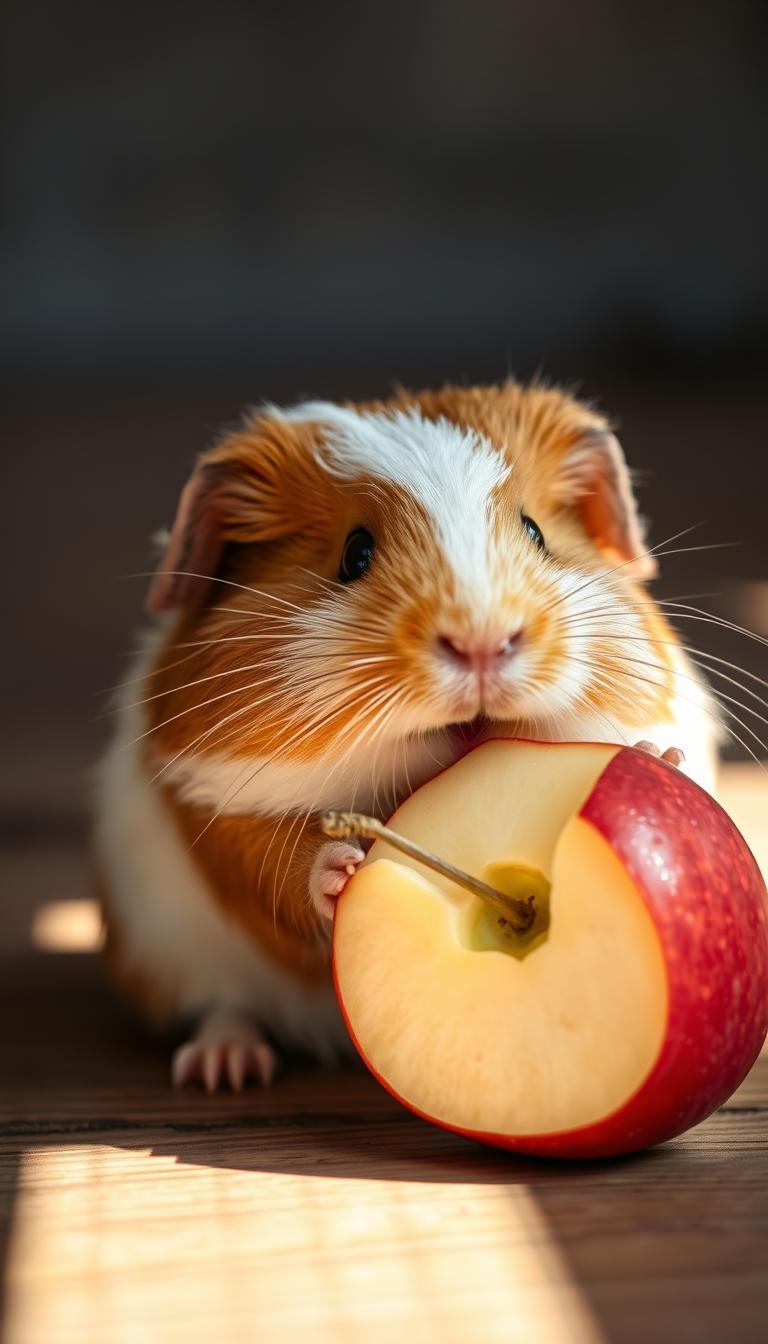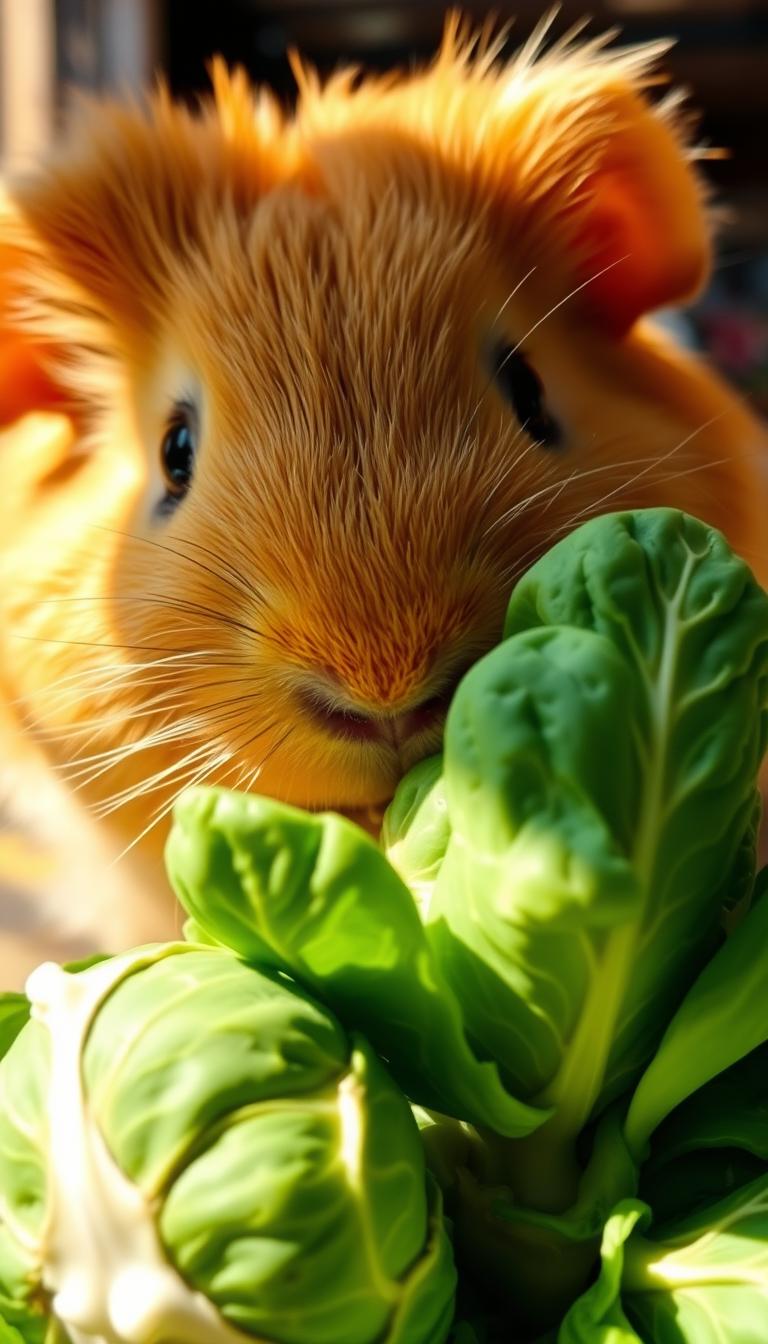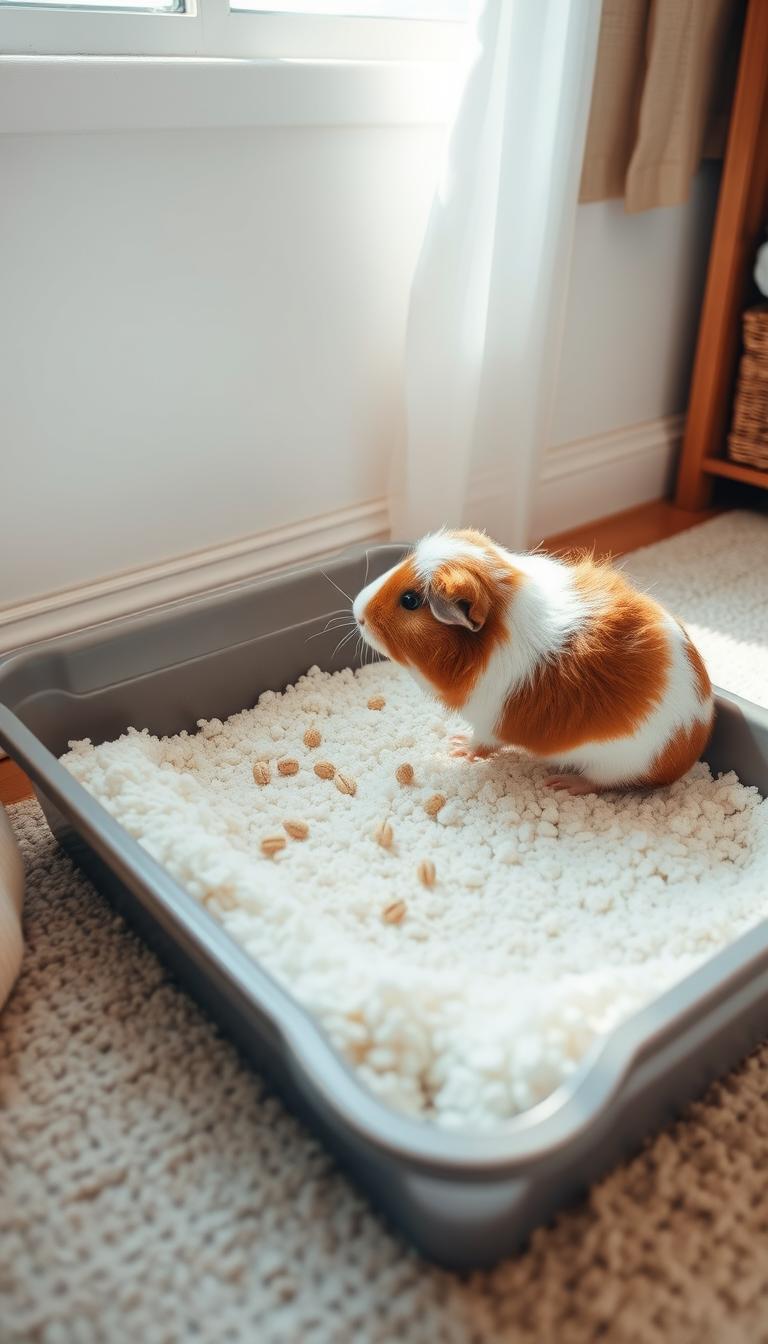Your furry companion can enjoy crisp, juicy treats when you understand safe feeding practices. Many pet owners wonder about incorporating fruits into their small herbivore’s diet, and properly prepared slices offer valuable nutrients. These sweet snacks provide vitamin C—a crucial element for preventing scurvy—along with fiber and antioxidants.
While these fruits make excellent occasional rewards, their natural sugar content means moderation matters. Experts recommend limiting portions to 1-2 small pieces weekly, ensuring your pet’s primary nutrition comes from timothy hay and fresh greens. Always remove seeds and apple cores to avoid choking hazards.
This guide explores how to balance taste and health, detailing portion sizes, preparation methods, and ideal frequency. You’ll discover why rotating treats maintains dietary variety while supporting digestive wellness. We’ll also compare nutritional benefits against potential risks, helping you create a meal plan that keeps your companion thriving.
Ready to learn how these crunchy favorites fit into a balanced diet? Let’s dive into the essentials of safe fruit feeding for your pocket-sized friend!
Table of Contents
Understanding Guinea Pig Nutrition
Small herbivores thrive when their meals mirror wild foraging habits. Native to South America’s grasslands, these animals evolved eating fibrous plants that keep their digestion smooth. Their unique biology requires careful food choices to prevent health issues.
Fiber First: Building Blocks of Health
Timothy hay makes up 80% of ideal daily intake. Its rough texture naturally files teeth while moving through the digestive tract. Pair this staple with dark leafy greens like spinach or kale for extra nutrients.
The Vitamin C Lifeline
Unlike humans, these pets can’t make their own ascorbic acid. Daily vitamin C intake prevents painful scurvy symptoms. Fresh veggies serve as better sources than supplements—bell peppers and parsley work great.
| Diet Component | Daily Amount | Key Benefits |
|---|---|---|
| Timothy Hay | Unlimited | Digestive health, dental care |
| Fresh Vegetables | 1 cup | Vitamins, hydration |
| Pellets | 1-2 tbsp | Supplemental nutrients |
Balance is key when introducing new foods. Always consult reliable sources before adding treats. Remember—what grows naturally in their habitat makes the safest choices for your companion.
Can Guinea Pigs Eat Apples?

These crunchy fruits make excellent occasional snacks when served responsibly. Fresh slices deliver vitamin C and fiber—nutrients that support immune function and digestion. Always remove seeds and cores before offering this sweet reward to avoid health risks.
Limit portions to thumbnail-sized pieces twice weekly. Their natural sugars can lead to weight gain if overfed. Rotate apple treats with other vitamin-rich options like blueberries or cucumber for dietary variety.
Most small pets adore the crisp texture and fruity flavor. Use these bites during bonding sessions or as positive reinforcement. Just remember—treats shouldn’t exceed 10% of daily food intake. Stick to 1-2 thin slices per serving to maintain nutritional balance.
Always introduce new foods gradually. Watch for changes in droppings or energy levels. If your companion shows enthusiasm without digestive upset, apples can become a safe rotational snack.
Nutritional Benefits of Apples for Your Guinea Pig

Crunchy fruit slices offer more than just a tasty snack—they deliver essential compounds that boost wellness. When served correctly, these treats become valuable supplements to your pet’s core diet of hay and greens.
High Vitamin C and Fiber
Every 100 grams provides 4.6 mg of vitamin C, helping meet daily needs to prevent scurvy. This nutrient supports immune strength and collagen production. The same serving contains 2.4g of fiber, promoting smooth digestion and consistent stool quality.
Fiber keeps your furry friend feeling full between meals. This reduces overeating risks while maintaining gut bacteria balance. Combined with regular hay intake, apple slices create a digestive harmony many small pets need.
Additional Nutrients for Overall Health
B-complex vitamins in these fruits aid carbohydrate breakdown and nerve function. Minerals like potassium regulate fluid balance, while magnesium supports muscle health. Iron contributes to oxygen-rich blood cells, enhancing energy levels naturally.
Natural anti-inflammatory properties help manage minor bodily stresses. Rotate apple treats with other vitamin-packed options for diverse nutrient intake. Always prioritize moderation—these benefits shine brightest when paired with balanced feeding habits.
Potential Risks and Safety Measures

While apples offer nutritional perks, responsible feeding requires awareness of hidden dangers. Two primary concerns demand attention: natural sugars and seed-related hazards. Let’s explore how to navigate these challenges while keeping treats enjoyable.
Sugar Content and Moderation
Fruit sugars accumulate quickly in small bodies. Just one medium apple contains 19 grams—equivalent to four teaspoons. Overfeeding can disrupt gut bacteria, leading to diarrhea or painful bloating.
Acidity compounds these risks. Tart varieties may irritate sensitive mouths if fed too often. Stick to sweet cultivars like Gala or Fuji, limiting portions to twice weekly.
Choking Hazards and Apple Seeds
Those tiny brown seeds pack double trouble. Their size risks airway blockage, while trace cyanide levels become toxic if ingested repeatedly. Always core fruit thoroughly before slicing.
Rotate apple treats with safer options like pitted cherries for variety. Monitor chewing behavior closely—uneaten pieces should be removed within two hours to prevent spoilage.
Balance remains crucial. When prepared mindfully and served sparingly, these fruits can safely enhance your pet’s diet without compromising health.
Preparing Apples for Guinea Pig Consumption

Proper preparation transforms apples into safe, nutritious snacks for small pets. Follow these steps to balance flavor with safety while preserving essential nutrients.
Washing and Peeling Considerations
Always rinse fruit under cool running water—scrub gently with a vegetable brush to remove dirt or chemical residues. The skin holds 50% of the fiber and key minerals, making it beneficial if your pet tolerates the texture.
Some companions prefer peeled slices for easier chewing. If using non-organic produce, peeling reduces pesticide exposure but sacrifices nutrients. Organic varieties with intact skins offer the best nutritional value.
Proper Cutting Techniques for Safety
Remove the core completely—seeds and stems pose serious health risks. Slice remaining fruit into ½-inch cubes or thin wedges. This size prevents choking while allowing easy gripping.
For younger or smaller pets, shred pieces further using a cheese grater. Always serve fresh portions immediately—oxidized brown slices lose vitamin C content rapidly.
Remember these key steps:
- Scrub thoroughly before slicing
- Cut around the core in a circular motion
- Adjust piece size based on your pet’s chewing ability
How to Introduce Apples to Your Guinea Pig’s Diet

Transitioning your pet to new foods requires careful planning and observation. Start with a rice-sized apple sliver if fresh produce isn’t part of their regular meals. Watch closely for 24 hours—soft droppings or reduced appetite signal it’s time to pause.
Successful introductions follow a three-step pattern:
- Offer fingertip-sized portions twice weekly
- Gradually increase to ½-inch cubes over 14 days
- Combine with other veggies like romaine lettuce
If your companion eagerly nibbles without digestive issues, slowly expand their fruity options. “Rotate treats every 3-4 days to maintain interest and nutritional balance,” suggests an exotic veterinarian’s feeding guide. Always discard uneaten pieces before they lose freshness.
Newcomers to fresh foods need extra patience. Aim for 1 tablespoon of mixed produce daily, working toward the ½-cup goal across several weeks. Pair apple slices with familiar favorites like cilantro to encourage exploration.
Remember—each animal has unique preferences. Some might sniff and walk away initially. Try different preparation methods: shredded pieces often entice picky eaters more than whole slices. Consistency without pressure helps build positive associations over time.
Monitoring for Allergic Reactions and Digestive Issues
Introducing new treats requires vigilance to ensure your pet’s well-being. Watch closely during the first two days after offering apple slices, as this period reveals how their system handles the change. Digestive sensitivity often shows quicker than immune responses in small animals.
Spotting Trouble Early
Look for unusual behaviors like refusing favorite foods or sitting hunched over. Soft droppings and audible stomach gurgles signal intestinal discomfort. Reduced water intake paired with lethargy warrants immediate attention.
Responding to Red Flags
If issues arise, remove all fruits and veggies from their menu immediately. Boost timothy hay availability to 90% of their diet—its roughage helps reset gut function. Hydration becomes critical; provide fresh water in multiple locations.
Persistent diarrhea beyond one day requires veterinary consultation. Small pets dehydrate rapidly, making prompt care essential. Document reactions in a feeding journal—note portion sizes, timing, and symptom progression for your vet’s review.
Most companions recover quickly with proper care. After symptoms resolve, you might reintroduce half a pinky-nail-sized piece under professional guidance. This cautious approach balances treat enjoyment with digestive safety.
Expert-Recommended Feeding Practices
Balancing treats with core nutrition keeps small companions healthy. Vets suggest offering ½-inch fruit cubes twice weekly alongside their regular hay and greens. This schedule prevents sugar overload while letting your pet enjoy natural sweetness.
Rotate apple pieces with other safe options like melon or berries. Remove uneaten portions within 24 hours to avoid spoilage. Freshness matters—discard any browned slices immediately.
Follow these guidelines for happy snack times:
- Serve treats during active hours when digestion works best
- Pair fruity bites with vitamin-rich veggies like bell peppers
- Track reactions in a food journal to spot patterns
Variety remains crucial. Aim for ½-cup daily of mixed produce, adjusting based on your guinea pig’s size and activity level. Always prioritize timothy hay as their main food source—it supports dental health and proper gut function.
Remember: moderation and observation make treat time both safe and enjoyable. Stick to expert portion sizes, and your furry friend will thrive!




